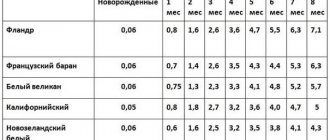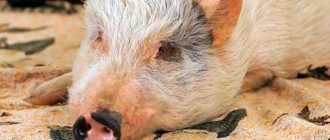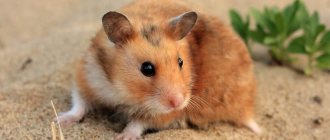Chihuahuas are dogs famous for their small size and light weight.
Due to the fact that this breed has several varieties that differ from each other in growth, all Chihuahuas grow differently.
What should a Chihuahua puppy weigh, depending on his age, how many months will he grow up to, and how much will he weigh when he grows up? And what should you do if, despite seemingly good care and proper feeding, your Chihuahua is not gaining weight well?
Why do you need to know your dog's height and weight?
In most dog breeds, intensive growth is observed before six months of age. For the correct formation of a puppy, proper feeding and maintenance are necessary in accordance with the appropriate conditions. When they are violated, underdevelopment is observed, which cannot always be corrected. Growth retardation is often explained by a lack of vitamins and mineral salts in the diet, so you need to constantly monitor development and know the normal weight of a Chihuahua by age. The optimal control method is weighing and measurements, which are performed from a month to two - every 5 days, from two to six - once every 10 days and then - monthly. Weighing should be done at the same time before feeding.
If Chihuahuas are smaller than normal, they do not tolerate heat and cold well, have health problems and weak immunity. Sneezing girls with insufficient body weight are unable to give birth to offspring.
Breed Features
The dog's body is longer than it is tall. This small animal has a tail that is always above its back.
The head is the most distinctive feature of this breed. The rounded skull is similar in shape to an apple. The eyes are bulging and round. This dog's ears are quite large and always remain in an upright position. The neck is moderately short, the muzzle is slightly elongated.
How to determine the size of a Chihuahua?
Several factors influence the size of Chihuahuas:
- genetics;
- completeness of the diet;
- conditions of detention;
- past illnesses;
- daily physical activity.
The weight of decorative dog puppies after birth is 7-8 times less than the offspring of large breeds. Then the difference increases to 100, but small species grow more intensively. At first, sneeze puppies are plump, with a decent subcutaneous layer of fat, which they need to retain heat and provide the body with energy. Later, Chihuahuas become slimmer and acquire an elegant appearance. By monitoring the dog’s parameters, it is easy to identify developmental abnormalities.
You can determine the size of Chihuahuas based on the characteristics of their parents. Most often, puppies copy them. At birth, each weighs about 5% of the mother's weight. At first they grow rapidly, by three months they reach half the weight of their parents, and by one year they grow to the size of an adult dog.
Character traits
Chihuahua is one of the pocket dog breeds. They are very friendly and cheerful in nature, making them perfect for families with children. They are quite strong and even similar to terriers in temperament - full of self-confidence. Of course, each dog is individual, but overall they are beautiful and even amazing animals.
What determines the weight of a Chihuahua dog?
The size of a Chihuahua depends on what type of dog it is (standard, small standard, mini and supermini).
Even within a particular species, sneezes can be miniature or massive, which is determined by genetic characteristics and hereditary diseases.
The dog's weight is influenced by the timing of the first estrus and mating. If they happen earlier than usual, growth may stop and not reach the indicators specified by the standard.
Low quality food, underfeeding or overfeeding a pet do not lead to a dog with ideal parameters. In the absence of a balanced diet, Chihuahuas often develop rickets, vitamin deficiency, pathologies of internal organs and joint diseases.
By their nature, decorative dogs are very active, but there are individuals who are not prone to physical activity. Such puppies quickly gain weight, while remaining lower at the withers than their brothers and sisters.
Another factor influencing weight is initial birth weight. As practice shows, the larger it is, the larger the dog at one year of age.
Learning ability
Training seems to be one of the Chihuahua's weak points. This doesn't mean they aren't smart enough to learn. With all this, these animals are driven by strong territorial instincts. Therefore, the dog will definitely guard the territory near the house and mark its boundaries.
Chihuahuas are really good obedience learners and can learn to follow commands consistently. This can actually help with the training issues that many owners face. Agility training also engages their thinking.
How old do Chihuahuas grow?
A puppy changes very quickly after birth. Chihuahuas develop faster than representatives of large breeds. In the first four weeks, the weight first doubles, then growth slows down, but the dog becomes an adult at the age of one year, and the body finally stops changing by the age of one and a half years.
Sneezes, who weighed 85 g at birth, weigh up to 1.5 kg at 18 months, increasing their weight 17 times. Over the course of nine weeks, they add 30-60 g, and the process can proceed in spurts. Between 17 and 25 weeks, weight gain slows down. The largest puppy at birth can weigh about 2 kg at 4 months.
By nine months, the teeth are completely replaced with permanent ones, and from this time on the dogs do not become heavier, but their chest increases in volume and their body becomes wider.
Girls
In most dogs, males are larger than females, which is enshrined in the breed standards. This rule does not work for Chihuahuas. Females weigh a maximum of 3 kg as adults, which allows them to bear and safely give birth to puppies. If the dog is less than 1.8 kg, major health problems arise. Such Chihuahua girls have weak immunity, a fragile physique and cannot give birth to offspring on their own. The optimal weight of females in adulthood is 2-2.7 kg.
Boys
Like females, male Chihuahuas grow actively until they are 6-7 months old. Their sizes are much smaller. For boys, a weight of 0.5-0.6 kg is acceptable. This applies to the mini look. Individuals from the standard category weigh from 1.3 kg to 2.7 kg with a height of 20-23 centimeters.
Main disadvantages
Any deviation from the accepted standard is a serious drawback. These include:
- flat or narrow skull;
- long and large muzzle;
- strong protrusion of the eyes or their small size;
- pointed or floppy ears;
- small neck;
- concave as well as curved spine;
- elongated body;
- misaligned jaw;
- small breast volume;
- completely thinning hair;
- sloping croup;
- narrow set of paws, as well as their curvature, etc.
Related article: When does shedding occur and what to do about Chihuahua shedding?
The presence of the above deviations affects the cost of the animal.
How much does the puppy weigh by week?
Chihuahuas grow faster than puppies of large breeds, despite the fact that they are born 70 grams with a large litter and 160 grams with a small litter. Babies actively gain weight from birth to three months of age. At 3 months, growth slows down. At 6 months, puppies are approaching the size of adults. To determine whether your pet is developing correctly, you can use a table that displays the relationship between weight and age of the puppy. The data allows you to compare the results and assign your Chihuahua to a certain category:
- standard line - from 2.3 kg to 3 kg in adulthood;
- small standard – should weigh from 1.8 kg to 3 kg at 6 months;
- mini - 1.5 kg-1.8 kg;
- supermini - (0.5 kg-1.5 kg).
| Age in weeks | Birth weight (g) | ||||||||
| 71 | 78 | 85 | 99 | 114 | 120 | 128 | 142 | 156 | |
| 1 | 105 | 112 | 143 | 155 | 185 | 199 | 228 | 256 | 268 |
| 2 | 141 | 155 | 185 | 199 | 256 | 285 | 313 | 355 | 384 |
| 3 | 171 | 199 | 228 | 256 | 313 | 368 | 396 | 455 | 497 |
| 4 | 197 | 228 | 268 | 313 | 368 | 453 | 483 | 538 | 596 |
| 5 | 228 | 256 | 313 | 368 | 426 | 483 | 554 | 625 | 681 |
| 6 | 256 | 313 | 355 | 426 | 497 | 568 | 625 | 681 | 766 |
| 7 | 285 | 341 | 412 | 483 | 554 | 625 | 696 | 766 | 853 |
| 8 | 311 | 368 | 455 | 538 | 611 | 681 | 766 | 823 | 937 |
| 9 | 340 | 426 | 497 | 568 | 653 | 736 | 823 | 908 | 993 |
| 10 | 368 | 455 | 538 | 625 | 710 | 795 | 878 | 965 | 1078 |
| 11 | 396 | 483 | 596 | 681 | 796 | 878 | 965 | 1048 | 1192 |
| 12 | 428 | 538 | 625 | 738 | 852 | 937 | 1050 | 1163 | 1277 |
| 13 | 455 | 568 | 682 | 795 | 908 | 1022 | 1135 | 1248 | 1388 |
| 14 | 481 | 625 | 738 | 855 | 965 | 1107 | 1220 | 1333 | 1475 |
| 15 | 539 | 653 | 795 | 908 | 1050 | 1163 | 1305 | 1447 | 1589 |
| 16 | 566 | 708 | 852 | 965 | 1107 | 1248 | 1390 | 1532 | 1674 |
| 17 | 594 | 738 | 878 | 1022 | 1163 | 1305 | 1447 | 1617 | 1759 |
| 18 | 624 | 795 | 937 | 1050 | 1218 | 1362 | 1532 | 1702 | 1844 |
| 19 | 653 | 823 | 964 | 1107 | 1248 | 1419 | 1589 | 1759 | 1898 |
| 20 | 681 | 852 | 993 | 1163 | 1305 | 1475 | 1645 | 1815 | 1986 |
| 21 | 708 | 878 | 1022 | 1192 | 1362 | 1532 | 1702 | 1872 | 2042 |
| 22 | 708 | 906 | 1048 | 1218 | 1388 | 1589 | 1759 | 1929 | 2099 |
| 23 | 736 | 935 | 1078 | 1248 | 1419 | 1617 | 1815 | 1986 | 2156 |
| 24 | 738 | 935 | 1105 | 1277 | 1447 | 1645 | 1845 | 2014 | 2212 |
| 25 | 766 | 945 | 1135 | 1333 | 1504 | 1702 | 1898 | 2071 | 2268 |
| 26 | 909 | 1136 | 1363f | 1588 | 1817 | 2045 | 2271 | 2498 | 2725 |
Based on the data, you can adjust the Chihuahua’s weight by changing the diet or intensity of physical activity (if necessary).
Peculiarities
The smallest pup in a litter may surpass its own littermates in size by the time all puppies reach one year of age. And it makes no difference whether it is a boy or a girl. All puppies grow almost the same.
The best method for determining how big a Chihuahua will become is to look at the pedigree. This will be considered his standard. Size, along with other physical traits, is hereditary.
The genetics passed on from the parents will undoubtedly affect the size of the Chihuahua; although looking back 3 generations will give you the best idea of your puppy's future size.
How much does a Chihuahua puppy weigh by month?
The physical condition of a sneeze should be monitored not only weekly, but also monthly. The data will show what is happening to the puppy. The owner can track periods of slower weight gain and compare them with the average Chihuahua weight data by month presented in the table:
| Age | Weight (g) | |||
| 72-78 g | 79-120 g | 121-145 g | 146-170 g | |
| At 1 month | 210-240 g | 260-380 g | 460-490 g | 550-660 g |
| At 2 months | 310-380 g | 450-615 g | 685-770 g | 830-1045 g |
| At 3 months | 430-550 g | 630-860 g | 950-1055 g | 1170-1410 g |
| At 4 months | 560-720 g | 860-1120 g | 1260-1395 g | 1540-1820 |
| At 5 months | 675-860 g | 990-1310 g | 1475-1655 g | 1820-2145 |
| At 6 months | 750-950 g | 1115-1445 g | 1650-1850 g | 2020-2415 |
| At 7 months | 860-1040 g | 1230-1660 g | 1815-2050 | 2220-2665 g |
| At 8 months | 970-1130 g | 1335-1510 g | 2110-2240 g | 2420-2925 g |
| At 9 months | 1010-1210 g | 1410-1870 | 1710-2310 g | 2510-3010 g |
| At 10 months | 1010-1210 g | 1410-1900 g | 1710—2310 g | 2510-3010 g |
| At 11 months | 1010-1210 g | 1410-1900 g | 1710—2310 g | 2510-3010 g |
| At 12 months | 1010-1210 g | 1410-1900 g | 1710—2310 g | 2510-3010 g |
Large discrepancies with the indicators are a reason to contact a veterinarian.
Mini
Mini Chihuahuas are born not only to the youngest parents. More often they appear as a result of mating of standard individuals. This applies to both short-haired and long-haired Chihuahuas. At birth, the baby weighs about 100 g. In a month, he triples his weight, and by six months he reaches 1200 g. The height at the withers of the minik during this period is 15 cm.
Standard
According to the FCI and RKF standard, a Chihuahua should weigh from 1.5 kg to 3 kg. There are no strict restrictions on height at the withers; approximate values are 12-21 cm. If a dog is more than 3 kg, this is recognized as a defect that allows it to be disqualified from exhibitions or competitions.
Limbs
Steady and strong front legs form a straight line with the elbows and are parallel to each other. When viewed from the side, you can see that the pastern is elastic and slightly oblique. The elbows are tightly pressed to the body.
Well developed hind legs are set vertically and are also parallel to each other, with a good angle of the hock joints. Narrow posture or weakness in the limbs are considered a defect.
The limbs have soft paw pads and long fingers with slightly elongated claws. Pay attention to how many fingers the puppy has. Dewclaws need to be removed.
How much does an adult Chihuahua weigh?
The average weight of an adult Chihuahua depends on its weight at birth. The larger it is, the larger the pet looks at 2 years and older. When checking the table and taking measurements, take into account that a deviation of 10% in both directions is considered normal.
| Weight in g | Supermini | Mini | Standard small | Standard |
| At the moment of birth | 75-85 | 95-120 | 120-130 | 135-170 |
| Adult dog | 1000-1400 | 1750-1950 | 2000-2300 | 2400-3000 |
The weight of an adult dog does not remain unchanged. At 3 years of age, Chihuahuas are at their peak of physical activity and may experience slight weight loss. After some time it will return to its average values. As pets get older, they become less mobile and may gain extra pounds.
Mini
The mini and supermini classifications appeared thanks to breeders who obtained individuals with a weight not exceeding 1 kg and 500 g, respectively, in adulthood. They are the ones who are most popular.
Standard
According to the official standard approved by the IFC, the ideal weight of a Chihuahua is between 1.5 and 3 kg, and the acceptable weight is from 0.5 to 1.5 kg. Too large a deviation is considered a rock defect. Such individuals are not allowed to compete and are not used for breeding.
Head
The Chihuahua's skull is very large, apple-shaped, the width and height of which are equal. The voluminous forehead has pronounced eyebrows.
Due to the convexity of the forehead, the transition to the muzzle is clearly visible.
The mini dog's muzzle, wide towards the base, tapers towards the nose. A short muzzle with poorly defined cheekbones has rounded, tightly fitting lips, the dry and tense structure of which should completely cover the teeth.
The small nose may be slightly turned up. The standard allows any color of the nose that matches the coat color.
The large, round eyes of the Chihuahua have an expressive, slightly sly look. Widely spaced ocelli suggest the presence of a deep furrow between them. They should not be too convex. The eye color is dark, matching the coat color, although the standard allows for a light color.
If you look at a Chihuahua from the front, then according to the standard, the eyes and nose of a mini dog form an equilateral triangle.
The standard allows for both scissor and level bites. But an undershot or vice versa - an undershot is already considered a defect. The set of teeth may not be complete - they do not attach much importance to this.
The animal's large ears are set high, wider at the base, tapering to a rounded tip. When the dog is calm, they hang at an angle of forty-five degrees, and when excited they take a vertical position and become closer to each other.
The neck is set high and has a slight bend at the top, without dewlap. In males it is more powerful.
Chihuahua growth by weeks and months
The breed standard does not indicate the height of the sneezes. Maintaining the proportions of the dog’s body is considered very important. Typically, height at the withers is 18-23 cm, chest volume is 26-37 cm, body length is 19.8-25.3 cm.
Up to 6 weeks the puppy grows in height. At this time, you can determine what kind of adult he will be. In six months, the Chihuahua's growth doubles, which is only possible with proper feeding, since it is at this time that the animal's muscles and bones develop. If you make mistakes during this period, it will be impossible to correct them later.
By six months, the dog stops growing, continuing to gain weight, becoming stronger and more proportional.
| Category | Height at the withers of an adult dog (in cm) |
| Standard | 17-23 |
| Small standard | 15-20 |
| Mini | 14-17 |
| Supermini | 12-14 |
Useful video
Useful and interesting facts about Chihuahuas:
join the discussion
Share with your friends
How big will your Chihuahua be when he grows up? At what age do Chihuahua puppies stop growing? The owner of a dog of this breed should know the answer to all these questions.











